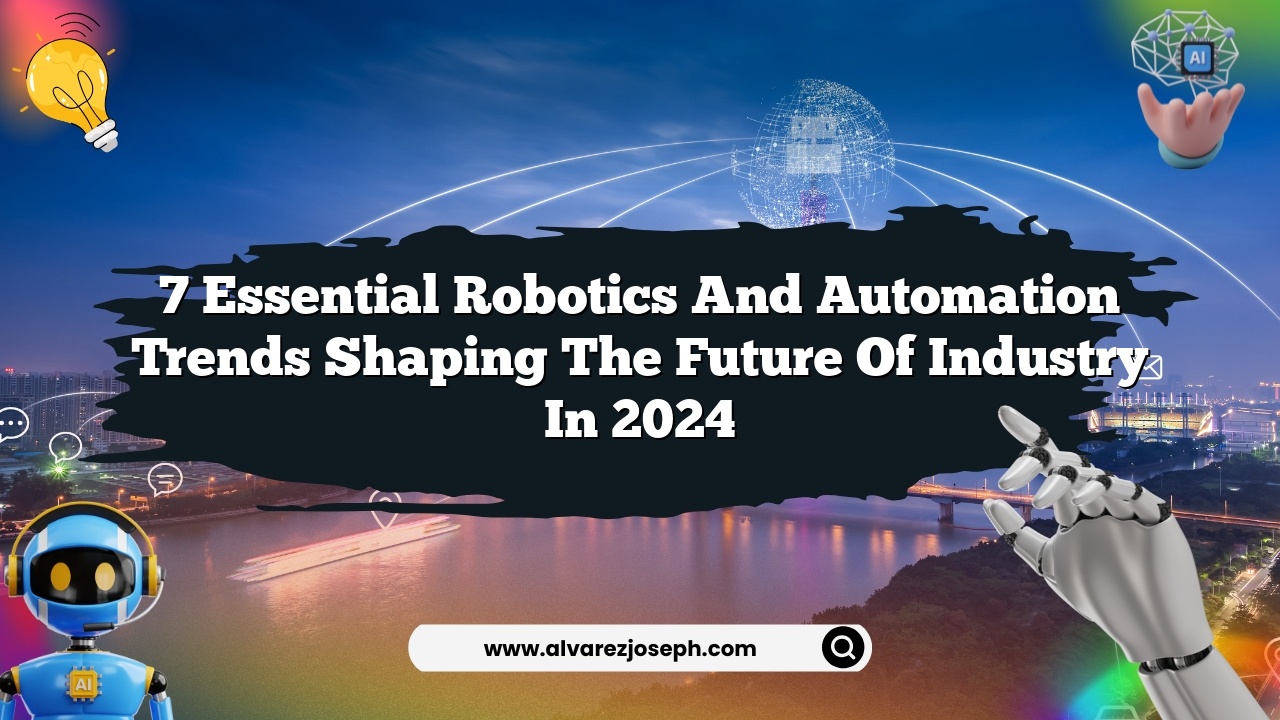Imagine waking up in a world where robots not only handle the mundane but also assist in making complex decisions that affect our lives and industries. As we approach 2024, the realm of robotics and automation is not just a sci-fi dream anymore; it’s becoming a tangible reality, reshaping the landscape of various industries. With advancements happening at lightning speed, it’s essential to stay ahead of the curve. What are the trends shaping this future? Buckle up, because we’re diving into seven essential robotics and automation trends that are set to change the game in 2024.
The Rise of Collaborative Robots (Cobots)
Gone are the days when robots were seen as mere tools confined to assembly lines. Today, collaborative robots, or cobots, are taking center stage. These machines are designed to work alongside humans, enhancing productivity without replacing the human touch. Imagine a factory floor where a human operator and a robot lift heavy components together, reducing the risk of injury and increasing efficiency.
Why Cobots are Gaining Traction
- Safety First: Cobots are equipped with advanced sensors that allow them to work safely around humans. They can detect when someone is nearby and slow down or stop, mitigating risks.
- Cost-Effective: Small and medium-sized enterprises (SMEs) are particularly benefiting from cobots. They provide an economical way to automate tasks without the hefty investment of traditional robotic systems.
- User-Friendly: Designed with ease of use in mind, cobots can be programmed without extensive technical knowledge. This democratizes automation, allowing companies of all sizes to harness the power of robotics.
But this isn’t where the story ends. The implications of cobots stretch far beyond the factory walls…
Integration of AI in Robotics
Artificial Intelligence (AI) is the brain behind many advancements in robotics. It empowers machines to learn from their environment and make real-time decisions. In 2024, we can expect AI to be even more integrated into robotic systems, enhancing their capabilities significantly.
The Power of AI in Robotics
- Predictive Maintenance: AI algorithms can analyze data from robotic systems to predict failures before they occur. This means less downtime and significant cost savings.
- Enhanced Learning: Through machine learning, robots can adapt to new tasks or changes in their environment, improving their efficiency and performance over time.
- Autonomous Decision-Making: Imagine a warehouse robot that optimizes its route in real-time based on traffic patterns and inventory levels. That’s the power of AI at work.
Curious about how this relates to your industry? Stick around; we’ll explore that in a bit!
Increased Demand for Robotic Process Automation (RPA)
In the age of digital transformation, companies are looking for ways to streamline operations. Enter Robotic Process Automation (RPA), a technology that uses software robots to automate repetitive tasks across various applications.
Why RPA is Essential
- Efficiency Gains: RPA can perform mundane tasks, such as data entry, faster and more accurately than humans. This allows employees to focus on higher-value tasks.
- Scalability: As businesses grow, RPA can easily scale to meet increased demand without the need for significant additional resources.
- Cost Savings: By automating tasks, companies can reduce operational costs significantly. Studies have shown that RPA can lead to cost reductions of up to 30%.
But wait—what happens when you combine RPA with AI? The potential is enormous, and we’re just scratching the surface…
The Emergence of Autonomous Vehicles and Drones
Picture this: delivery drones soaring through the skies, autonomously navigating to your doorstep. From self-driving cars to drones delivering packages, autonomous vehicles are not just a futuristic idea; they’re becoming a reality in 2024.
The Impact of Autonomous Technology
- Efficiency in Logistics: Autonomous vehicles can optimize routes in real-time, reducing fuel consumption and delivery times. In an age where speed is everything, this is a game-changer.
- Safety Improvements: With advanced sensors and AI, these vehicles can make real-time decisions to avoid accidents, potentially reducing road fatalities.
- New Business Models: Companies are exploring subscription services for autonomous transportation, fundamentally changing how we think about mobility.
How does this innovation impact urban landscapes? Let’s take a closer look…
Smart Manufacturing and Industry 4.0
The concept of Industry 4.0 revolutionizes manufacturing through the integration of IoT (Internet of Things), AI, and robotics. Smart factories leverage these technologies to create more efficient and flexible production processes.
Key Features of Smart Manufacturing
- Real-Time Data: Machines and sensors communicate data in real-time, allowing for immediate adjustments to production processes.
- Customization: Customers increasingly demand personalized products. Smart manufacturing enables companies to respond quickly to these changes without major overhauls.
- Sustainability: Improved efficiency means less waste. Smart factories are designed to reduce their environmental footprint, appealing to eco-conscious consumers.
Curious about how this affects your everyday life? Just think about the potential for customized products that fit your needs perfectly!
Advancements in Human-Robot Interaction
As robots become ever more integrated into our lives, human-robot interaction (HRI) is becoming a critical area of study. Companies are focusing on making robots more intuitive and responsive to human emotions and actions.
Enhancing HRI
- Natural Language Processing (NLP): This allows robots to understand and respond to human speech, making communication smoother and more intuitive.
- Emotional Recognition: Robots equipped with sensors can gauge human emotions and react accordingly, creating a more engaging interaction.
- User-Centric Design: Developers are focusing on making robots that are not just effective but also relatable, enhancing user experience.
Imagine chatting with your home assistant in a way that feels natural and engaging—it’s closer than you think!
The Role of Sustainable Robotics
With climate change at the forefront of global concerns, the need for sustainable technology in robotics has never been more pressing. In 2024, we can expect a surge in the development of eco-friendly robots.
Sustainable Robotics Trends
- Energy Efficiency: New robotic designs prioritize energy conservation, utilizing renewable energy sources when possible.
- Recyclable Materials: Manufacturers are beginning to use materials that are easier to recycle, reducing waste.
- Eco-friendly Applications: Robots are being deployed to assist in environmental monitoring, waste management, and even cleaning oceans.
As we navigate these trends, one question remains: How can we ensure that automation benefits everyone?
Quick Summary
- Collaborative Robots (Cobots) are enhancing productivity by working alongside humans.
- AI Integration empowers robots to make autonomous decisions and improve efficiency.
- Robotic Process Automation (RPA) streamlines operations, saving costs and improving productivity.
- Autonomous Vehicles and Drones are changing logistics and transportation.
- Smart Manufacturing leverages IoT for real-time data and customization.
- Advancements in Human-Robot Interaction focus on intuitive communication and emotional recognition.
- Sustainable Robotics emphasizes eco-friendly practices and applications.
Frequently Asked Questions
What are collaborative robots (cobots)?
Cobots are robots designed to work alongside humans, enhancing productivity and safety in various tasks.
How does AI impact robotics?
AI enables robots to learn, make autonomous decisions, and improve their efficiency over time.
What is Robotic Process Automation (RPA)?
RPA uses software robots to automate repetitive tasks, increasing efficiency and reducing costs.
What role do autonomous vehicles play in industries?
They optimize logistics, improve safety, and introduce new business models for transportation.
How is smart manufacturing different from traditional manufacturing?
Smart manufacturing integrates IoT and AI technologies for real-time data and increased customization.
Why is human-robot interaction important?
It enhances user experience, making robots more relatable and effective in everyday tasks.
In conclusion, the landscape of robotics and automation is not just an exciting future; it’s unfolding right before our eyes. As we embrace these trends, the only question that remains is how we’ll adapt and integrate these innovations into our daily lives. And you, how would you apply this in your life?












